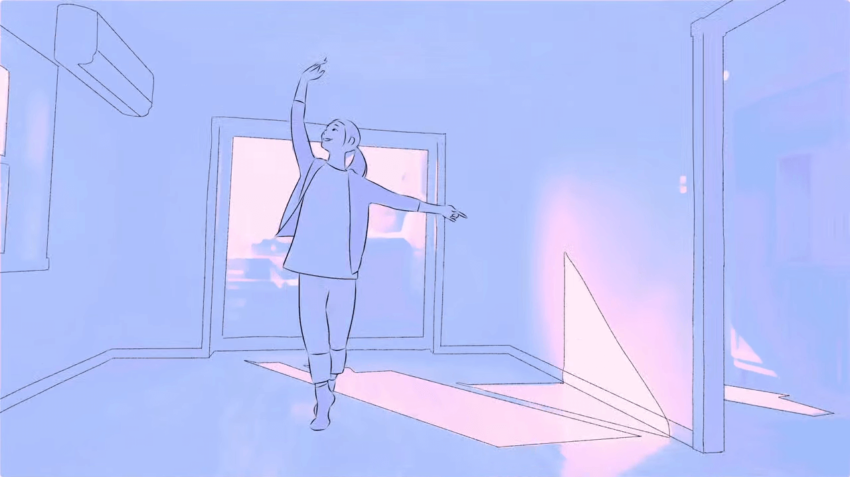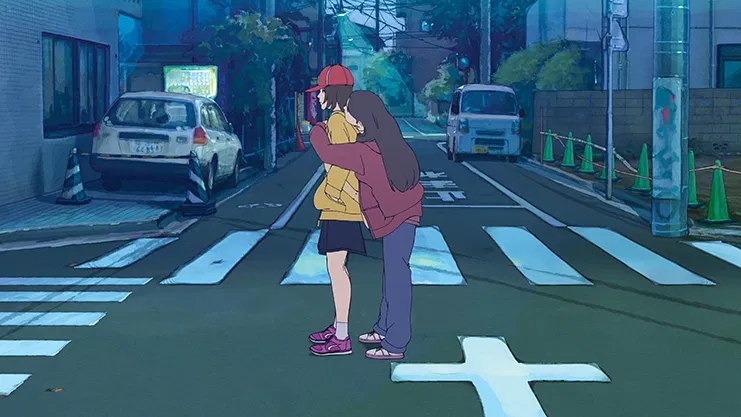Interview: Shunji Iwai
January 29, 2021 · 0 comments
By Andrew Osmond.

The delightful comedy-drama The Case of Hana & Alice is a kind of anime, except that it was filmed first in live-action, then converted into animation via traced drawings and CG software. The novel technique is used to tell an offbeat story. Set in contemporary Japan, it’s about two eccentric teen girls who team up to solve the mystery of a “missing” student, which leads them into comic misadventures. It’s a fond portrait of adolescence and friendship that’s also very funny.
The film was directed by a relative newcomer to anime, Shunji Iwai, who’s chiefly made his name in live-action film in the last two decades. There’s an in-depth run-down of his work elsewhere on this blog. He’s respected in Japan – in 2016, he was one of the “directors in focus” at the Tokyo Film Festival, along with Mamoru Hosoda. However, he’s less well-known in Britain. One of his biggest international successes is his 2001 live-action film, All About Lily Chou-Chou. It originated as a message board about a non-existent pop idol and then became a bleak teen drama, discussed in the interview below.

The Case of Hana & Alice is actually a prequel to another of Iwai’s live-action films, just called Hana & Alice. This 2004 film (which is far sunnier than Lily Chou-Chou) also originated on the net, as a series of web shorts. It was successful in Japan, and made the names of its two lead actors, who voice the characters again in the animated prequel. However, the live-action Hana & Alice wasn’t big overseas, though you may be able to find it on R1 DVD.
Luckily, there’s absolutely no need to have seen it to enjoy the animated prequel, which shows the characters’ first meeting. The Case of Hana & Alice charmed audiences at 2016’s Scotland Loves Anime, where it won the Audience Award (although the festival judges argued hotly about if it was “animated” or not). It’s not quite unique as anime – it came out a couple of years after the TV series Flowers of Evil, another rotoscoped dark teen-drama – but it’s still a most unusual specimen.
It’s Iwai’s only animated feature film, but he’s had a couple of other brushes with anime. Early in his career, he made a live-action TV film called Fireworks, about a boy and a girl who end up in a timewarp. If it sounds familiar to you, that’s because Fireworks was remade 24 years later as a feature-length anime by the SHAFT studio, though Iwai didn’t direct that version (more details here).

Also, Iwai himself took the lead role in an unjustly obscure live-action film called Shiki-Jitsu or Ritual Day, made in 2000. It was directed by Hideaki Anno, soon after he’d theoretically “ended” Evangelion. In the fascinating film, Iwai effectively plays Anno’s burnt-out stand-in, opposite actress Ayako Fujitani, the daughter of Steven Seagal.
However, Iwai focused on The Case of Hana & Alice in the following interview, conducted when he visited Glasgow in 2016.
Why did you make The Case of Hana and Alice with rotoscoped animation?
It was important to me to use live actors, because I’m used to making live-action film. So rather than try to explain every movement for the animators to draw, it was easier for me to create the movement and the scenes together with the actors and then turn that into animation. I used two techniques. One is standard rotoscoping; the other is 3D CG to animate the characters. In both cases, though, we had real actors moving and acting the parts.

With the rotoscoping, we’d trace their movements of the actors that we’d filmed. My first encounter with rotoscoping had been Ralph Bakshi’s U.S. film American Pop. [Bakshi’s animated musical melodrama was released in 1981; Iwai caught it in 2000 on Japan’s WOWOW channel.] American Pop inspired me, because I’d noticed that Japanese animation was taking the same form more and more, falling into a set pattern. It was something I was getting a bit fed up with, and seeing American Pop’s different way of animating, of moving, was fresh and inspiring.
In rotoscoping, faces tend to look very real. As you know, anime characters tend to be very kawaii, cute caricatures. The plan was to make the Case of Hana & Alice characters more like cute anime characters, but using rotoscoping. I thought that if I could achieve that, it would really be something new.
For the CG in Hana and Alice, we would create a 3D model based on what we’d filmed. The CG didn’t involve sensors being put on the actors (motion-capture); rather we overlaid the 3D model onto the actors and followed their movements. For the main characters, 70% of their animation used 3D models, and the other 30% of their animation used rotoscoping. Standard rotoscoping (tracing) was used for the characters who were ‘extras.’
You’ve said that making the film was very difficult. What are the main disadvantages with the methods you used on this film?
It was my first time making animation, and there isn’t really anyone who does rotoscoping in Japan. Despite asking around, I couldn’t find anyone who was very experienced in rotoscoping, so everything was done from scratch. It’s the same with 3D modelling; it’s not widespread, so it was quite hard to get my head around the workflow. We could make the models, but then I wasn’t sure how to correct them when something wasn’t right, for example. The overall scheduling, how to handle the data files, how to bring everything together, these were all difficult.

Then in order to get people to work on the rotoscoping, I auditioned people from around the country, who I found online, who were very good at drawing. In the end I had 150 people around the country sending me files by email. (I was at home, not in a studio!) Everything was done online. It was quite a tough and complex process and I think quite unique; I’m not sure any production studio in Japan has worked on something like this.
Previously, I had written and produced a film called Baton. [Made in 2009, Baton was a rotoscoped anime science-fiction film, one of the first of its kind.] That was the first time I worked with rotoscoping, but there was no way to do it in Japan, so we had to get a team together in America. We cast very famous Japanese actors in Baton, but the US team didn’t know the actors, so they found it hard to reproduce the faces. In a sense, Baton was a kind of test, a preparation for The Case of Hana & Alice.

The Case of Hana & Alice was made at a similar time as a Japanese TV series called Flowers of Evil, which also used rotoscoping. Did you have any communication with people on that series?
The director of Flowers of Evil, Hiroshi Nagahama, was also involved in Baton; I think he learned about rotoscoping there, so that’s the connection.
In The Case of Hana & Alice, the titular duo seems to be very eccentric girls.
Even though the protagonists are children, I wanted them to be playing out a story that could be something played out by adults. What happens if you give them things [to do] that adults would normally do? How would the story play out if children are the protagonists? Adults would know how to solve the issues, or they might give up. But children, as we see in the film, keep going even if they have to sleep under a car; they have a particular persistence.
The two main voice-actresses, Anne Suzuki and Yu Aoi, were teenagers when they played the parts of Hana and Alice in the original live-action Hana & Alice. (Around the same time, Suzuki also voiced the hero of Katsuhiro Otomo’s Steamboy.) Was it difficult for them to return to the characters of Hana and Alice, now they were a decade older?
It wasn’t that difficult. I think that once Japanese girls turn 15 or 16, their voices and looks don’t change that much, so I think I could make more [Hana & Alice stories] and it would still be fine.

Did any of the voice-actors also perform the physical movements which were rotoscoped for the film?
Most of the main actors were different, including the actors performing the movements for Hana and Alice themselves. (Aoi and Suzuki just provided their voices.) We didn’t have such a big budget for The Case of Hana & Alice, so we couldn’t afford to have all the (voice) actors do the live-action filming… Ideally, we would have had the same person doing both the voice and the movements. However, you can get the voices recorded in one day, as opposed to the month it took to film the live-action, and it’s going to be animated anyway.
Your 2001 live-action film All About Lily Chou-Chou presented an often horrifying picture of Japanese teenage life (the story involves rape and suicide). The Case of Hana & Alice is much more cheerful. Which vision do you think is closer to reality?
Both films depict the same layer of Japanese society, and I think they both exist in Japanese society. Some people will look at Lily Chou-Chou and think it’s just like what’s happening in their own lives; others will think they’ve never had that kind of experience. Some people will watch The Case of Hana & Alice and think it’s nothing to do with them, and others will think it’s spot on. It depends on where you are, what surroundings and environment you’re in. I think parents, when choosing schools for their children, try to choose somewhere where the kinds of things (shown in Lily Chou-Chou) don’t happen, which is probably hard work.
The Case of Hana & Alice is released in the UK by Anime Limited.
Leave a Reply